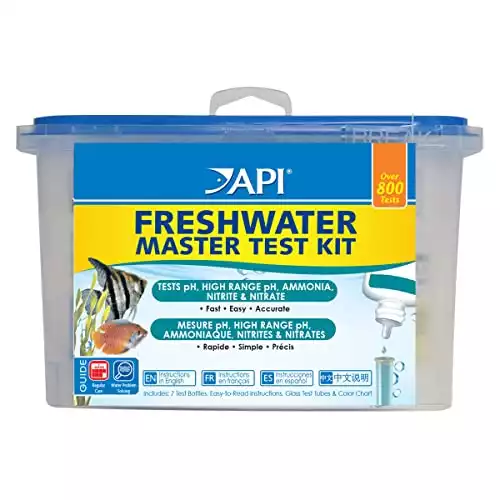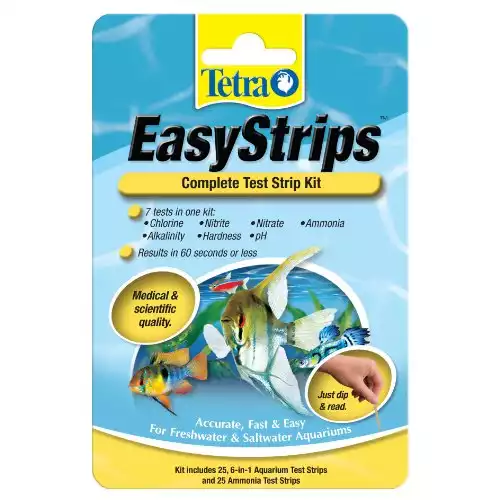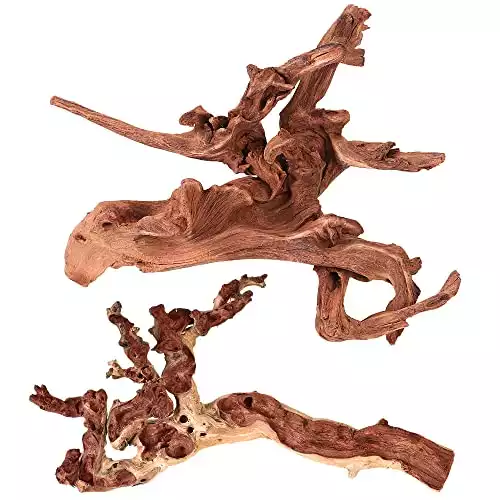
Before going ahead and lowering your aquarium’s pH level, are your fish showing any signs of distress? If you answered no, I’d leave the pH level where it is.
Maintaining a consistent pH level is far more important than trying to chase the perfect pH level.
Fish are sensitive to changes in water chemistry and changing the water pH level too much will cause them stress.
What is pH?
Water pH (pH stands for potential hydrogen) is a scale that measures the number of hydrogen ions relative to the number of hydroxide ions in a solution.
In this case, the solution is the water in your aquarium.
The scale ranges from 1 to 14.

A solution with a pH level of 7 has an equal amount of hydrogen and hydroxide ions and is therefore pH neutral.
A solution with a pH level below 7 has more hydrogen ions and is acidic.
A solution with a pH level above 7 has more hydroxide ions and is alkaline, which is also referred to as being basic.
The smaller the number on the scale is, the more acidic the solution is. The higher the number, the more alkaline the solution is.
The pH scale is logarithmic, which means the difference between each stage increases by a factor of 10.
- pH7 is neutral, so pH6 is 10x more acidic than pH7.
- pH5 is 10x more acidic than pH6, and 100x more acidic than pH7.
- pH8 is 10x more alkaline than pH7.
- pH9 is 10x more alkaline than pH8, and 100x more alkaline than pH7.
You can see how a slight increase in pH level makes a massive change to the water chemistry in your fish tank.
What’s The Ideal pH For a Fish Tank?
The ideal pH for a fish tank depends on the type of fish you keep.
In an ideal world, it’s best to measure your tap water pH and keep fish that are best suited to that pH level, rather than trying to manually adjust it.
Your aquarium’s pH level will fluctuate slightly throughout the day, it’s something that happens naturally, so when you take a pH measurement it’s important to do it at the same time of day.
Most fish can happily live in a water pH level between 6.5-8.0.
There are a few exceptions to the rules, African cichlids for example prefer a pH of 8.0 and above, whereas South American cichlids prefer a pH of around 6.0.
I’m sure you’ve seen the shelf labels in the pet store stating what pH level a particular fish requires, this can be confusing to new fish keepers, who think they have to chase the ‘perfect pH level’ for the fish to survive.
It is much more important to keep a consistent pH level than to be chasing the ‘ideal’ number.
Fish are very sensitive to changes in pH level and shouldn’t have more than 0.3 change in 24 hours, so if you do change your pH level using any of the methods below, it needs to be done gradually.
Constantly changing the water chemistry is a surefire way to cause your fish to be stressed out, leaving them vulnerable to illness and diseases.
What Causes High pH In Aquariums?
There are a few things that can cause the pH level to rise in your aquarium.
Substrate & Tank Decor
Certain substrates, rocks, and shells are high in calcium and other minerals which will over time leach into the water and increase the pH level.
Too Many Plants
Plants are a great way of giving your tank’s nitrogen cycle a boost as they remove a lot of harmful toxins from the water, including carbon dioxide.
Carbon dioxide lowers the pH level in your aquarium water thus making the water acidic.
However, having too many plants could deplete your aquarium of carbon dioxide and raise the water’s pH level gradually over a prolonged period.
Water Changes
If your source water has a higher pH than your aquarium water, then this will cause an increase in your aquarium’s pH level when you refill it.
Symptoms Of High pH In Fish Tank
Symptoms of having a high pH level in a fish tank include:
Burns
Your fish may show signs of chemical burns on or around their eyes, gills, and scales. These burns can be very painful, or even fatal.
High Ammonia Levels
Higher pH water makes it easier for ammonium to turn into highly toxic ammonia and you can quickly end up with ammonia poisoning on your hands.
Tank Overrun With Algae
Some algae growth is a good sign that your tank is cycled fully.
However, higher pH water can lead to rapid green algae growth which can quickly overrun your tank.
Sick Fish
If the water pH level is above what your fish can tolerate, this can cause your fish to become stressed.
Your fish may swim erratically, scratch themselves against the substrate, gasp at the surface, or try to jump out of the tank.
When a fish is stressed its immune system is suppressed leaving them vulnerable to various parasitic infections and illnesses such as dropsy, ich, popeye, and swim bladder disease.
How To Monitor pH In Aquariums
You have a few options for monitoring your water pH level.
Water Test Kits
Testing your water regularly is a great way to monitor the pH levels, test kits will also monitor ammonia, nitrite, and nitrate.
4.7 | 4.5 |
The API freshwater test kit offers outstanding value (over 800 tests!) and is very accurate, if you're serious about fishkeeping this is the best test kit to buy and the only one I use. | The Tetra test strips are quick & easy to use and measure all the vital water parameters that you need to monitor to keep your fish safe, but it can be difficult to read the colors, making them less accurate than the API water test kit. |
$13.49 | |
The API freshwater test kit offers outstanding value (over 800 tests!) and is very accurate, if you're serious about fishkeeping this is the best test kit to buy and the only one I use.
The Tetra test strips are quick & easy to use and measure all the vital water parameters that you need to monitor to keep your fish safe, but it can be difficult to read the colors, making them less accurate than the API water test kit.
Digital pH Gauge
If you want a more accurate pH reading, a digital meter is a great option.
While the test kits and strips work well and are convenient, the digital gauge is much more accurate than comparing the results to a color chart.
A digital gauge gives you measurements to within 0.01 rather than 0.5, so you’ll know exactly where your water pH level is at.
This pH meter can test the pH levels at 0.01 increments, giving you a very accurate reading for your aquarium water.
An added bonus is this meter also measures TDS (total dissolved solids) and temperature, so when used in conjunction with a water test kit, you get a good overall view of the health of your aquarium.
How Often Should I Test Aquarium pH?
I test my tank’s pH weekly for new tanks and when cleaning with more established tanks.
Testing regularly and logging the test results will help you keep on top of keeping your aquarium safe and stable for your fish.
You’ll soon be able to spot when something isn’t right and take the necessary action to fix it.
Test your water at the same time on your chosen day to ensure the most accurate and consistent results, as pH naturally fluctuates throughout the day.
How To Lower Aquarium pH Naturally?
If you’re wondering how to bring pH down in an aquarium, wonder no more! I have 5 safe and natural solutions for you.
1. Driftwood
Aquarium-safe driftwood is a natural way to lower the pH level in your aquarium.
It also provides somewhere for your fish to explore and rest on.
Soak overnight before adding to your aquarium, so that it sinks to the bottom & doesn't float away!
My No.1 choice when it comes to lowering aquarium pH is driftwood.
Not only does it look great, but it also provides fish with somewhere to hang out and unwind.
Driftwood slowly releases tannins into the tank water giving it a yellowy brown coloration.
If you don’t like the coloration you can add some activated carbon to your filtration system.
Make sure you buy aquarium-safe driftwood, wood that is designed for a reptile enclosure may have other chemicals in it that are harmful to fish.
I recommend sanding down any sharp points on the driftwood to avoid your fish injuring themselves.
2. Catappa Leaves (Indian Almond)
Indian Almond Leaves give a natural look to your aquarium, as well as the added benefit of lowering the pH level.
They have natural anti-bacterial & fungal properties, so are great for your fish's health.
Fish love to hide under the leaves and Betta fish will use them for breeding.
The tannins released will turn your tank water a browny-yellow color. The coloring is harmless to your fish, but if you don’t like it, add some activated carbon to your filtration system.
The leaves will float around your tank which looks natural, but it’s not to everyone’s liking. You could tie a few together and place them inside your filter if that’s the case.
You’ll have to replace the catappa leaves periodically as they decay in the water. How long this takes depends on the water chemistry in your tank.
3. Peat Moss / Granules
Fluval Aquatic Peat Granules are a natural way of lowering the pH of your aquarium.
They can be a little messy to use, so I recommend putting the granules inside a mesh bag, and placing the bag inside your filter if you have space.
Alternatively, hang the bag near the filter output for maximum benefit.
Peat moss is another naturally found substance that’s great for lowering your water pH level.
The key with peat moss is adding a little bit at a time over several days and monitoring the water’s pH level. If you add too much too soon you could see a huge drop in water pH.
Like driftwood and catappa leaves, it releases tannins into the water and could turn your tank water to the color of tea.
To minimize this, you could soak the peat in clean water for 4-5 days before adding it to your fish tank.
4. Reverse Osmosis
The iSpring Reverse Osmosis system is a great long-term solution if your tap water has naturally high pH levels.
It won't discolor your aquarium water like driftwood, Indian almond leaves, and peat granules can, so it's an excellent choice for those of you who want crystal-clear water.
You'll also have the added benefit of having amazing tasting chemical-free drinking water too!
The iSpring RCC7 5-stage reverse osmosis filtration system is a quality RO system.
A reverse osmosis filter works by filtering out mineral deposits and chemicals like pesticides and heavy metals in water.
An RO system is not the cheapest way of lowering your aquarium’s pH, but you do get the added benefit of having nice clean drinking water too!
Something to be aware of with some cheaper RO units is that they don’t remove chloramine from the water (this system does), so you would need to do that separately if your tap water contains chloramine.
Some people wonder if a Brita filter would work as a cheaper alternative, but it’s not as practical or as good as a RO system.
5. Water Changes
Using the Python system takes the hassle out of cleaning your aquarium and performing water changes.
No cumbersome buckets full of fish poop water will need to be carried through your home again!
It's available in 4 different lengths from 25 feet - 100 feet.
It can take a little time to get the hang of using it correctly to begin with, but after a few tries you'll wonder how you ever managed without it.
Regular tank maintenance and water changes are essential parts of keeping your water parameters in check.
When performing water changes you re-balance the minerals in your tank, which can help lower the pH level.
I have a detailed guide on how to clean a fish tank that will take you through this process step by step.
How To Lower pH In Aquarium FAQ
Some questions I hear a lot on how to lower pH in an aquarium are:
Why Is My Aquarium pH So High?
There could be any number of reasons why your aquarium’s pH is high.
The first thing to check is the tap water that you use to fill your tank. Is that a high pH? If so use one of the methods above to lower your water pH level.
If the pH of the tap water is okay, something within your tank is causing the pH level to rise…time to investigate…
Do you have an alkaline substrate or any decor items that are leaching minerals into the water?
Do you have too many plants in your tank?
How Do I Fix High pH In My Aquarium?
The best ways to fix high pH in a fish tank are the solutions I suggested above, driftwood, capatta leaves, peat moss, or a reverse osmosis device.
Can I Lower pH In Aquarium With Vinegar?
Yes, you can lower your aquarium pH with vinegar, but you need to measure the vinegar carefully to avoid a huge pH swing.
I recommend using a syringe to get an accurate measurement.
Before you add any vinegar, take a reading of your aquarium’s pH level so you know how much you need to lower it.
Add only 1ml of vinegar per 1 gallon of water. The ratio has been proven to lower your aquarium pH level by 0.3, the maximum pH level change you should expose your fish to in 24 hours.
Add the vinegar to an area of high water flow so it gets mixed properly around the tank.
After 24 hours have passed, test your water pH again to see if you need to add more vinegar to your tank water.
What Happens If pH Is Too High In Fish Tank?
Having a pH level that’s too high can be disastrous for your fish’s health due to them receiving chemical burns around their eyes, gills, and scales.
They can become stressed out which leaves them vulnerable to various bacterial and parasitic infections and illnesses.
Final Thoughts On How To Lower pH In An Aquarium….
I’m a big believer in the adage ‘if it ain’t broke, don’t fix it.’
As I’d said in the intro, if your fish are healthy, don’t risk stressing them by lowering your water’s pH level if you don’t need to.
If you need to lower it, my preferred method is to add aquarium-safe driftwood or Indian almond leaves, but if you have nasty tap water the RO system is the best option.
For more guides on keeping your tank in tip-top shape, check out the aquarium health section.








